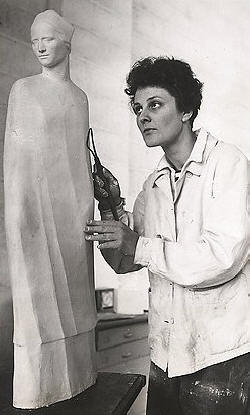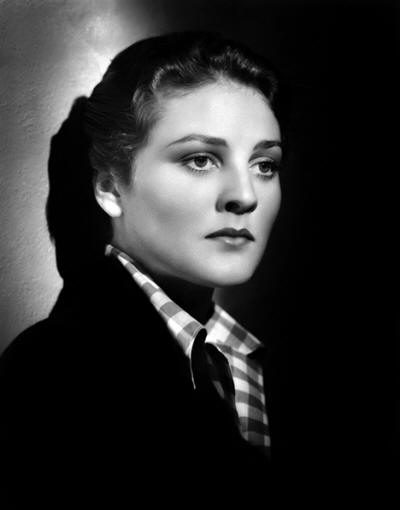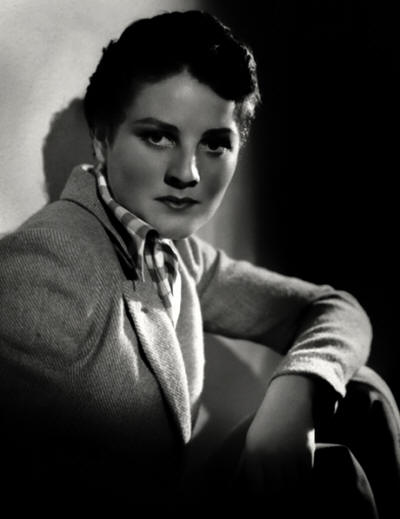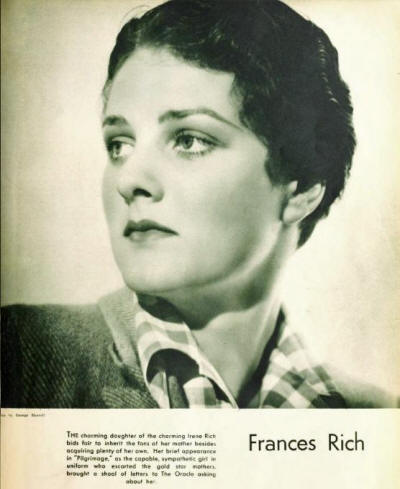

Queer Places:
Smith College (Seven Sisters), 9 Elm St, Northampton, MA 01063
Shumway Ranch, Shumway Ranch Rd,
Palm Desert, CA 92561
30842 Broad Beach Rd, Malibu, CA 90265
 Frances Rich (born Irene Frances Lither Deffenbaugh; January 8, 1910 – October 14, 2007) was an American actress, artist, and sculptor. Her sculpture graces the Union Building at Purdue University; the Army - Navy Nurse monument in Arlington National Cemetery; Madonna House at Combermere, Ontario Canada; Millesgarden, Lindingo, Sweden; American Shakespeare Festival Theater at Stratford, Connecticut; Holy Trinity Church in Bremerton, Washington; Grace Cathedral in San Francisco and many art galleries and private collections around the world. She was the daughter of actress Irene Rich.
Katharine Hepburn did not make
her home with Spencer Tracy but rather within a community of women.
Laura Barney Harding, Emily
Perkins,
Constance Collier,
Eve March,
Frances Rich,
Phyllis Wilbourn, and finally
Cynthia McFadden were the ones to provide
anchor, solace, and family.
It was the presence of two women in Kate’s circle that raised the most
speculation in the Hollywood rumor mill. Whenever Hepburn traveled back East,
she often had Nancy Hamilton or
Frances Rich at her side. Neither woman ever married, nor did they put up
smoke screens about male beaux. Look-alikes, both Hamilton and Rich wore their
hair short and boyish, eschewed makeup, and were rarely seen without ties and
trousers. To look upon either of them was to imagine that Sylvester Scarlett
had nimbly stepped off the screen.
Frances Rich (born Irene Frances Lither Deffenbaugh; January 8, 1910 – October 14, 2007) was an American actress, artist, and sculptor. Her sculpture graces the Union Building at Purdue University; the Army - Navy Nurse monument in Arlington National Cemetery; Madonna House at Combermere, Ontario Canada; Millesgarden, Lindingo, Sweden; American Shakespeare Festival Theater at Stratford, Connecticut; Holy Trinity Church in Bremerton, Washington; Grace Cathedral in San Francisco and many art galleries and private collections around the world. She was the daughter of actress Irene Rich.
Katharine Hepburn did not make
her home with Spencer Tracy but rather within a community of women.
Laura Barney Harding, Emily
Perkins,
Constance Collier,
Eve March,
Frances Rich,
Phyllis Wilbourn, and finally
Cynthia McFadden were the ones to provide
anchor, solace, and family.
It was the presence of two women in Kate’s circle that raised the most
speculation in the Hollywood rumor mill. Whenever Hepburn traveled back East,
she often had Nancy Hamilton or
Frances Rich at her side. Neither woman ever married, nor did they put up
smoke screens about male beaux. Look-alikes, both Hamilton and Rich wore their
hair short and boyish, eschewed makeup, and were rarely seen without ties and
trousers. To look upon either of them was to imagine that Sylvester Scarlett
had nimbly stepped off the screen.
Frances Rich was born as Irene Frances Lither Deffenbaugh on January 8, 1910 in Spokane, Washington, U.S. to silent screen actress Irene Frances Luther Rich and salesman Elvo Elcourt Deffenbaugh.[1] Her step-father was Charles Rich, who adopted her when he married her mother.[1] Rich attended Smith College, from which she graduated in 1931. Her original name was Deffenbaugh, being the daughter of her mother’s first husband, Elvo Deffenbaugh. Irene Rich’s second husband, Major Charles Rich, later gave his name to the young Frances.
Frances Rich appeared in six films in the early 1930s: Unholy Love (1932), The Thirteenth Guest (1932), Officer Thirteen (1932), Diamond Trail (1933), Zoo in Budapest (1933), and Pilgrimage (1933). She also appeared on Broadway in Brief Moment at the Belasco Theatre from November 1931 through February 1932.
Born in Spokane, Washington, Rich received a B.A. from Smith College in 1931. In 1933 she met sculptor, Malvina Hoffman, and studied with her in Paris for two years.[2] Upon returning to America, she did intensive work at the Boston Museum School and established her own studio in New York City. Between 1937 and 1940 she was a resident student at Cranbrook Academy of Art. There she met sculptor Carl Milles, with whom she worked for the next eighteen years. Her works include portrait busts at Smith College; the Army-Navy Nurse Monument in Arlington National Cemetery in Washington, D.C.; a bronze pelican in front of Pelican Building, University of California, Berkeley; marble bust of Alice Stone Blackwell for the Boston Public Library (featured on the Boston Women's Heritage Trail);[3] and portrait busts of Lotte Lehmann, Margaret Sanger, Diego Rivera, Katharine Hepburn, among others. Architectural sculpture by Rich includes six monumental limestone bas reliefs at the Purdue University student union building, executed in 1938.[4]



During World War II, Rich served in the United States Naval Reserve achieving the rank of Lieutenant Commander. Katharine Hepburn met Fran Rich through Jack Ford. Possessed of a sharp wit, Fran had fired off a few cutting comments about “that old Bryn Mawr” when she’d first discovered Ford’s affair with Hepburn. But she could also be sentimental, crying “real salt tears” over a Chaplin film with her friend Noël Sullivan, a San Francisco arts patron. Rich’s soul, said one acquaintance, was “alive with the great gothic vibration.”
Kate was clearly enchanted by Fran. “We were very close for a time, always together,” Rich acknowledged, though she declined to characterize the relationship further. But Rich’s friends remembered the fondness she used in describing her travels with Kate, and from Hepburn’s own anecdotes it’s obvious she adored sitting on a stool posing for Fran, who would sculpt half a dozen likenesses of her over the years. Sometimes the attention came double, as Rich would arrange for their mutual pal Robert McKnight, Kate’s erstwhile “beau,” to bring over his hammer and chisel as well.
Both Hamilton and Rich were part of the “upper-class bohemian” world that defined Hepburn’s inner circle. But as always, however, the private reality of Kate’s life wouldn’t play to the masses. A great deal of insulation would be needed, a buffer zone of protective fiction.
Early in May 1951, Kate left London for Rome, where the company was scheduled to rendezvous before heading to the Congo. There she enjoyed two reunions. The first was with Fran Rich, who’d set up a studio in Rome, trying her hand at bronze liturgical sculpture. The two women hadn’t seen each other in some years. Meeting Kate at the airport in her little Fiat Giardinetta wagon, Fran zipped her along the old Appian Way, both of them talking a blue streak and laughing a great deal. “We always had so much fun together, and I had missed her so much,” Rich remembered. After several years of playing hausfrau to Spencer Tracy, Kate seems to have been energized by this reconnection with a close woman friend. That night, Fran treated Hepburn to a moonlight tour of Rome. The next day they picnicked at Ostia Antica at the mouth of the Tiber River, picking wildflowers at the ruins of the Neptune Baths. “It was just so lovely to be together again,” Fran would recall.
But Kate’s reverie with Fran was short-lived. On May 13, Spencer arrived in Rome for a meeting with Pope Pius XII, a lifelong dream of his. It had been several months since he’d last seen Kate. If we read between the lines of Kate’s memoir of the shooting of The African Queen, it seems their months apart had left a mark on the couple. Kate found Spence distant, but as usual, she did not pry into what was bothering him.
The papal meeting was scheduled for a week later at a special reception in Vatican City. Forty other pilgrims, including the Scottish writer A. J. Cronin, would take part. In the meantime, Fran played guide for Tracy as well, touring him around churches and the Roman countryside, though not in her little Fiat. Spence insisted they use the limousine provided by MGM. At her apartment, littered with bronze shavings, Fran cooked dinner for Kate and Spence. Afterward, she drove Tracy back to his room at the Grand Hotel. Kate, as ever, did not join him but stayed with Fran.
When, immediately after his audience with the pope, Spencer left without saying good-bye, Kate was hurt. “Did he leave because he was bored or did he leave because he couldn’t bear to say goodbye?” she asked, years later. “The eternal question.”
Kate presumed he left for London to fly back to the States, but in fact he stopped in France for a tour of the Alps. Kate also seemed not to know that Louise was being given an honorary degree from Northwestern University on June 11, and Spencer wanted to be home by then. If she had been hoping he’d stick around Rome until she left for Africa, Kate was disappointed. Fran Rich would later wonder if Tracy liked her; she could never tell, she admitted. Had he, possibly, been uncomfortable with her friendship with Kate?
In late 1960, both Kate and Spence traveled to Hawaii. Tracy was filming The Devil at 4 O’Clock on location there. The trip would be romanticized as a secret retreat for Kate and Spence away from the eyes of prying reporters. In fact, though Kate met up with Tracy and enjoyed spending time with him, she was traveling with Fran Rich, as postcards she sent to John Ford prove.
“Kate never traveled with Tracy alone,” said one of her friends. “There was always Fran Rich, or Phyllis, or someone. And it wasn’t about secrecy or propriety the way it’s been assumed. It was just how they lived. They’d all have dinner together, then Kate would go off with Fran on a boat. Kate might go with Spencer to some shindig with the film crew but then she’d go back to Fran or Phyllis Wilbourn or whichever one of her girls she’d brought along.”
In the spring of 1961 (after a tour of the Middle East in which they’d visited Iraq, Egypt, and Jerusalem), Phyllis was with Kate in Paris when they met up with Spencer, who’d just finished making Judgment at Nuremberg. Fran Rich was also with them, working on another sculpture of Kate.
Over the next two years, Kate would spend much of her time in West Hartford with her family. Though her father continued to decline, she did find time to travel with Fran Rich, who offered refuge from her family pressures. “Seen a lot of Kate at Hartford,” Fran wrote to John Ford. “Old boy is failing rapidly ... Mind you, he doesn’t miss much.... He’s as sharp as a tack when he makes the effort. But this will permit the body to keep on and on. Very tough on all concerned.”
Searching for a new creative environment, Fran Rich and her mother, Irene Rich, purchased the old Shumway Ranch on Highway 74 in Pinyon crest in 1962. They refurbished the old ranch house and built another nearby to house Fran Rich’s studio, classrooms and living quarters. The studio was perfection, lighted from the north and with ceilings high enough to accommodate the tallest of the sculptor’s creations. The living room provided, at once, a view of the cosy patio and swimming pool on one side, and the whole sweep of the Coachella Valley on the other. Purchased in 2017 by the Coachella Valley Mountains Conservancy and other agencies, the ranch was previously home to writer Nina Paul Shumway who wrote Mountain of Discovery about her mountain home, as well as other entertaining accounts of desert life. Frances used the main house, guest cabins and outbuildings as an elite arts colony, inviting her famous friends from Hollywood and New York. A visitor in 1969 said the talk at the table was as witty and intellectual as the Algonquin Round Table.
It was Alice Palache who arranged the rental of Kate’s latest house in Los Angeles. With Spencer needing more constant care, Kate understood she would once again need a regular base on the West Coast; and if she was forced to spend time in L.A. during the summer, she wanted to be on the beach. Palache settled on the publicist Frank McFadden’s house on Broad Beach Road at Trancas Beach, not far from where Kate had shot Sylvia Scarlett.
It might not be Fenwick, but McFadden’s beachfront house was perhaps the coziest of all of Kate’s West Coast addresses. A paneled living room was arranged around a large fireplace, the kitchen finished in knotty pine. Glass doors opened onto an enormous deck overlooking the dunes and the Malibu coastline. From their perch up in the Hollywood hills, Spencer and George Cukor frequently made the trip down to join them.
Later this house would be described as a “hideaway” for Kate and Spence. The Associated Press journalist James Bacon called it the “house Tracy shared with Hepburn,” where they “carried on one of Hollywood’s great illicit romances.” But Fran Rich said it was she, not Spencer, who was there for much of the spring and summer of 1963. Still, any visit from Spencer was enough to set tongues wagging, including that of the house’s owner, Frank McFadden, who apparently gave Bacon the impression of a Tracy-Hepburn secret love nest. Of course, if Kate and Spencer had really wanted to be secret, they’d have simply stayed put at the bungalow on Cukor’s estate, where complete privacy was assured. The fact was that the house at Trancas Beach simply reflected Kate’s desire to be on the water.
By 1965, Spence had also warmed to Fran Rich, who welcomed him and Kate to the home in Palm Springs she shared with another woman. It was there that Kate sculpted her famous three-inch bust of Spencer. Painting, sculpting, swimming in Fran’s pool, Kate and Spence loved Palm Springs. Under a purple desert sky, ringed by the San Jacinto Mountains, they’d sit with Fran and her friend, talking late into the night.
For the next decade or so, the core group around Hepburn included old faithfuls like Laura Harding, Eve March, and Fran Rich, as well as newer friends like Sue Seton and Laura Dubman Fratti. After Katharine Cornell died in 1974, Nancy Hamilton also moved back into Hepburn’s inner circle. Sharing a love for chocolate, the two women could consume several pans of Kate’s famous brownies in one sitting. When Nancy died in 1985, her will specified that Kate be given five hundred dollars’ worth of the best dark chocolate.
Kate’s intimates were quite a diverse lot. Some had been married with children (Eve March, Laura Fratti, Norah Moore) while others were lifelong singles (Nancy Hamilton, Fran Rich, and most of the women Kate and Nancy socialized with on Martha’s Vineyard). Of them, only Sally Lapiduss would ever publicly identify as lesbian, though Hamilton’s relationship with Katharine Cornell was well-known in theatrical circles.
In 1977, after flying to Los Angeles to pack the last of her belongings from Cukor’s bungalow, Kate retreated—mantelpiece in hand—to Fran Rich’s house in Palm Springs, where she licked her wounds and let her old friend console her. Due to her recent skin surgery, she kept herself covered from “head to toe” in the desert sun, even if it spoiled “the fun of air and walking,” as she told David Eichler.
In Me: Stories of My Life (1991), whole chunks of Hepburn's life with Spencer were being conflated one on top of the other. Timelines were blurred. Separations were forgotten. Important relationships—Irene, Fran Rich, Bobby Helpmann—were left out almost altogether. But the biggest omission was the fact that Kate had left Spencer in 1952, not to mention all that had led up to it.
Frances Rich died in Payson, Arizona on October 14, 2007, aged 97. The John Ford Collection contains several letters from her, from the 1930s through the 1960s. For their entire lives, Ford and Rich shared a deep friendship. It would be Rich who persuaded Ford to move to the desert near Palm Springs later in his life.
My published books: